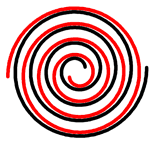Involute
An involute of a curve is the locus of a point on a piece of taut string as the string is either unwrapped from or wrapped around the curve.
The notions of the involute and evolute of a curve were introduced by Christiaan Huygens in his work titled Horologium oscillatorium sive de motu pendulorum ad horologia aptato demonstrationes geometricae (1673), where he showed that the involute of a cycloid is still a cycloid, thus providing a method for constructing the cycloidal pendulum, which has the useful property that its period is independent of the amplitude of oscillation.
is the starting point from where the arc length is measured.
The vector corresponding to the end point of the string (
results in an involute corresponding to a string extended by
(like a ball of wool yarn having some length of thread already hanging before it is unwound).
and/or adding a number to the integral (see Involutes of a semicubic parabola).
one gets In order to derive properties of a regular curve it is advantageous to suppose the arc length
to be the parameter of the given curve, which lead to the following simplifications:
follows: The family of involutes and the family of tangents to the original curve makes up an orthogonal coordinate system.
First, draw the family of tangent lines.
Then, an involute can be constructed by always staying orthogonal to the tangent line passing the point.
The first type is at the point where the involute touches the curve itself.
For example, this maps the circle into the hyperboloid of one sheet.
is vertical (parallel to the z-axis), which can only occur where the surface in
Generically, the surface has vertical tangent planes at only two cases: where the surface touches the curve, and where the curve has an inflection point.
For the first type, one can start by the involute of a circle, with equation
Explicitly, one may solve for the polynomial expansion satisfied by
, we obtain the involute passing the origin.
By serial expansion, it has parametric equation
term is optional; it serves to set the start location of the curve on the circle.
extensively simplifies further calculation, and one gets Eliminating t yields
The other involutes are not tractrices, as they are parallel curves of a tractrix.
, one gets (after having used some trigonometric formulas) and Hence the equations of the corresponding involute are which describe the shifted red cycloid of the diagram.
Between involutes and evolutes the following statement holds: [4][5] The most common profiles of modern gear teeth are involutes of a circle.
In an involute gear system, the teeth of two meshing gears contact at a single instantaneous point that follows along a single straight line of action.
With teeth of other shapes, the relative speeds and forces rise and fall as successive teeth engage, resulting in vibration, noise, and excessive wear.
For this reason, nearly all modern planar gear systems are either involute or the related cycloidal gear system.
[6] The involute of a circle is also an important shape in gas compressing, as a scroll compressor can be built based on this shape.
The High Flux Isotope Reactor uses involute-shaped fuel elements, since these allow a constant-width channel between them for coolant.








